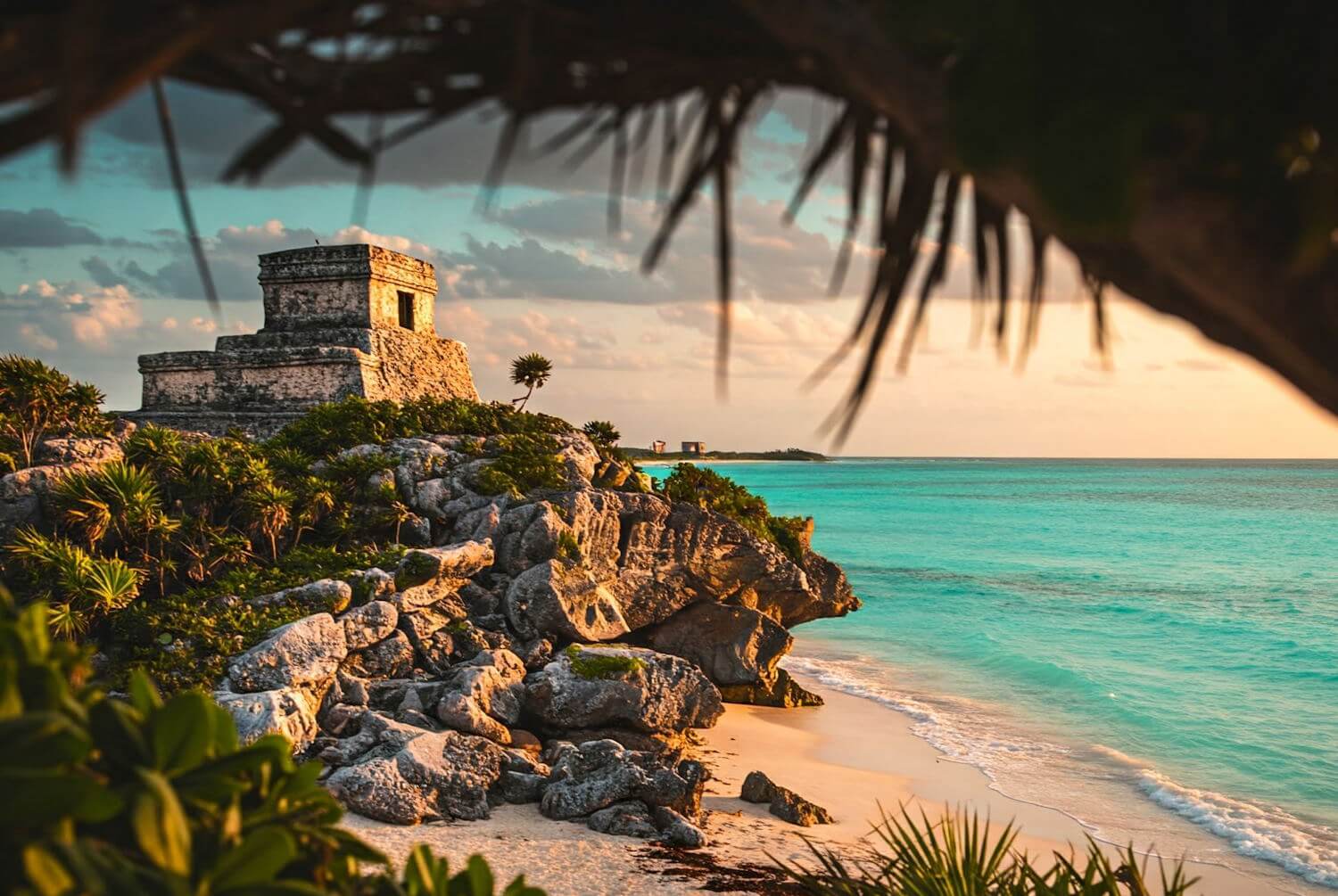Introduction to the Yucatán Peninsula
The Yucatán Peninsula, located in southeastern Mexico, is a region renowned for its rich cultural heritage, stunning natural landscapes, and significant historical legacy. Bounded by the Caribbean Sea to the east and the Gulf of Mexico to the north and west, this remarkable peninsula spans three Mexican states: Yucatán, Quintana Roo, and Campeche. Its geographical location not only offers breathtaking coastal vistas but also serves as a bridge connecting Mexico with the wider Caribbean and Central America.
This area is culturally significant, especially due to its deep-rooted connection with the ancient Mayan civilization. The Mayans thrived in this region, leaving behind an impressive array of archaeological sites that provide invaluable insights into their sophisticated society, notable achievements in mathematics and astronomy, and elaborate religious systems. Among the most remarkable locations are Chichén Itzá, a UNESCO World Heritage Site, and Tulum, perched on cliffs overlooking the turquoise waters of the Caribbean. These ancient ruins serve as popular attractions, drawing travelers eager to explore the remnants of a vibrant civilization.
The Yucatán Peninsula also boasts an array of natural wonders, including cenotes—natural sinkholes filled with crystal-clear waters—and diverse ecosystems ranging from lush jungles to pristine beaches. Such features enhance the region’s allure, attracting not only history enthusiasts but also nature lovers and adventure seekers. Visitors can partake in various activities, such as swimming in cenotes, exploring biosphere reserves like Sian Ka’an, and enjoying the area’s vibrant marine life through snorkeling or scuba diving. Ultimately, the Yucatán Peninsula offers an unforgettable journey that seamlessly intertwines ancient history with breathtaking natural beauty.
The Rich History of the Mayan Civilization
The Mayan civilization, renowned for its intricate society and impressive achievements, originated in Mesoamerica around 2000 BCE. Stretching across modern-day Mexico, Guatemala, Belize, Honduras, and El Salvador, the Mayans developed a rich culture characterized by advanced agricultural practices, complex political systems, and profound spiritual beliefs. They are perhaps best known for their monumental architecture, elaborate cities, and sophisticated understanding of astronomy, which collectively lay the foundation for their legacy that continues to captivate scholars and tourists alike.
One of the most remarkable contributions of the Mayan civilization is its architectural innovations, seen in iconic structures such as the pyramids of Tikal and the temples of Palenque. These buildings not only exemplify the advanced engineering skills of the Mayans but also served significant religious and ceremonial functions, reflecting the society’s deep cosmological beliefs. During the Classic Period (250-900 CE), the Mayans achieved notable advances in the arts and sciences, evidenced in diverse art forms and intricate hieroglyphic scripts that documented their history, astronomy, and daily life.
Moreover, the Mayan calendar system and their profound knowledge of celestial bodies allowed them to predict astronomical events with precision, showcasing their expertise in astronomy. This understanding greatly influenced their agricultural cycles and religious rituals, emphasizing the interconnection between their cosmological worldview and practical life. As historians and archaeologists continue to uncover more about this once-thriving civilization, it is evident that its history is not merely a matter of the past; it remains a vital context for comprehending the ruins that dot the Yucatán Peninsula. By grasping the cultural significance of the Mayan achievements, visitors can enrich their experiences at these sites, gaining insights that reflect a profound legacy left by an extraordinary civilization.
Key Mayan Ruins to Explore
The Yucatán Peninsula is home to some of the most significant and iconic Mayan ruins, each showcasing the grandeur of the ancient civilization. Among these, Chichén Itzá, Tulum, and Ek’ Balam stand out as prime examples highlighting the architectural sophistication and cultural depth of the Maya.
Chichén Itzá is perhaps the most renowned Mayan site, famed for its impressive pyramid, El Castillo. This step pyramid, dedicated to the god Kukulcán, demonstrates the Maya’s advanced understanding of astronomy. Notably, during the equinoxes, the play of light creates an illusion of a serpent descending the pyramid’s steps. Visitors should plan to arrive early to avoid crowds and take advantage of guided tours that delve into the site’s history.
Tulum, perched dramatically on a cliff overlooking the Caribbean Sea, offers visitors stunning views alongside its historical significance. Known as a fortified port, Tulum is one of the last cities built and inhabited by the Maya. The site boasts a well-preserved wall surrounding the central structures, with the Temple of the Frescoes displaying exquisite murals. To enhance your experience, consider visiting either early in the morning or late in the afternoon to enjoy the tranquility and capture the beauty of the sunset amidst the ruins.
Ek’ Balam, lesser-known but equally fascinating, is notable for its exceptional preservation and intricate carvings. The name ‘Ek’ Balam’ means ‘Black Jaguar’ in the Mayan language, and the ruins reveal much about the culture and cosmology of the Maya. The central pyramid showcases dramatic stucco sculptures and an intriguing entrance framed by jaguar carvings. To fully appreciate the site, visitors can also climb to the top of the pyramid for panoramic views of the surrounding jungle.
When planning a visit to these remarkable ruins, it is advisable to invest in guided tours to gain insights into their historical and cultural contexts. Additionally, punctuality is key; arriving early will afford you a more immersive experience while showcasing the magnificence of these ancient sites.
Cultural Significance of the Ruins
The Mayan ruins scattered across the Yucatán Peninsula are not merely relics of a bygone civilization; they serve as vital cultural touchstones for contemporary Mayan communities. These ancient structures, including iconic sites such as Chichen Itza and Tulum, hold profound spiritual significance. For local populations, the ruins are reminders of their ancestry, embedding a rich tapestry of history, tradition, and identity that influences their daily lives. The spiritual connection to these sites is often manifested in rituals and ceremonies that honor their ancestors and the deities associated with the Mayan cosmology.
In the contemporary context, the preservation of Mayan ruins has become crucial to maintaining cultural identity amid globalization and modernization. As tourism continues to grow, endeavors to protect these historical sites reflect a commitment to ensuring that the legacy of the Mayan people lives on. Local communities actively engage in initiatives to preserve the ruins, ensuring that they are not only tourist attractions but also living symbols of Mayan culture. This proactive approach includes collaboration with archaeologists and conservationists to secure funding and resources necessary for site maintenance and restoration while prioritizing the voices of the locals.
The importance of these efforts extends beyond mere preservation; they provide a platform for cultural expression and education. Workshops, tours, and cultural festivals centered around the ruins allow the Mayan people to share their traditions with visitors, fostering a greater understanding of their heritage. These interactions promote respect for the past while integrating it into the fabric of modern life, illustrating that the ruins are dynamic, ever-evolving symbols of Mayan identity. In essence, the ruins offer a window into the past while firmly rooting contemporary Mayan culture in its historical narrative.
What to Expect When Visiting the Ruins
When embarking on a journey to explore the ruins of the Yucatán Peninsula, it is essential to be well-prepared to make the most of your experience. The region is renowned for its rich history and astonishing archaeological sites, with highlights including Chichén Itzá, Tulum, and Ek’ Balam. To ensure a smooth visit, consider the following practical information.
Timing your visit is crucial; generally, the best months to explore the ruins are from November to March, when temperatures are milder, and the chances of rain are lower. If you prefer a quieter experience, visiting early in the morning or late in the afternoon on weekdays can help avoid large crowds. Online ticket booking is recommended for popular sites, especially during peak tourist seasons. Many ruins also offer guided tours, which provide invaluable insights into the Mayan culture and history, making the experience even more enriching.
Dress comfortably to accommodate the warm climate while also respecting the cultural significance of these sites. Lightweight, breathable clothing is advisable, along with a good pair of hiking shoes for navigating uneven terrain. A hat and sunglasses can provide additional protection from the sun. Bring ample water and snacks to stay hydrated, particularly when exploring larger sites that may lack food vendors.
As you stroll through the ruins, practicing proper etiquette is paramount. Always remain on designated pathways to preserve the integrity of the sites and avoid touching structures or artifacts. Photographs are generally permitted, but be respectful of other visitors and follow posted guidelines. Engaging with the local guides in a courteous manner can enhance your understanding of the cultural heritage embedded within these ancient wonders, ensuring a rewarding visit.
Experiencing Local Cuisine
The cultural tapestry of the Yucatán Peninsula is enriched not only by its stunning landscapes and historical sites but also by its diverse and flavorful cuisine, deeply rooted in ancient Mayan traditions. To fully immerse oneself in this vibrant destination, sampling local cuisine is essential. The culinary experience here provides insight into the heritage and customs that have shaped the region over centuries.
One iconic dish that visitors should not miss is cochinita pibil, which features slow-roasted pork marinated in achiote and citrus, yielding a delectable combination of flavors. Traditionally prepared in an underground pit, this dish serves as a testament to the ancient cooking techniques still cherished in modern Yucatán kitchens. Another must-try is pozole, a rich hominy soup typically made with pork or chicken and flavored with spices. This comforting dish exemplifies the communal nature of Mayan dining, often enjoyed during special gatherings and celebrations.
In addition to these quintessential dishes, tantalizing local beverages, such as horchata (a refreshing rice drink) and agua de chía (chia seed water), offer a refreshing complement to any meal. To experience the best of Yucatán’s culinary offerings, travelers should venture into local markets, such as Mercado Lucas de Gálvez in Mérida, where fresh ingredients, traditional snacks, and street food abound, providing an authentic taste of daily life.
For those seeking guided culinary experiences, there are numerous local restaurants and eateries that focus on traditional recipes. Restaurants like Casa de los Abuelos and El Mercado 60 not only serve delicious meals but also showcase the rich history behind each dish. By exploring the local cuisine of the Yucatán Peninsula, visitors can gain a deeper appreciation for this enchanting region and the flavors that have shaped its identity.
Wildlife and Natural Wonders
The Yucatán Peninsula is not only renowned for its historical significance and Mayan ruins but also for its remarkable biodiversity and breathtaking natural beauty. This region is home to a wide variety of flora and fauna, which enriches its ecological landscape. The unique combination of tropical jungles, coastal ecosystems, and expansive wetlands fosters a habitat for countless species, making it a paradise for biologists and nature enthusiasts alike.
Many visitors to the Yucatán are captivated by its cenotes—natural sinkholes filled with crystal-clear water that provide a unique swimming experience and excellent opportunities for snorkeling and diving. These cenotes have significant cultural relevance; they were revered by the ancient Mayans, believed to be sacred portals to the underworld. Swimming in these enchanting waters immerses visitors in both environmental and cultural exploration, offering a seamless connection to the natural world that the Mayans esteemed.
In addition to cenotes, the Yucatán Peninsula boasts several ecological parks that highlight its biodiversity. For instance, Sian Ka’an Biosphere Reserve is a UNESCO World Heritage Site, known for its extensive marshes and mangroves, as well as its diverse wildlife, including manatees and numerous bird species. Visitors to this ecological park can engage with nature through guided tours, showcasing the importance the environment held for the ancient Mayan civilization.
The Mayans had a profound connection with nature, viewing it as an integral part of their spiritual and daily lives. They believed that the natural world was filled with deities, each governing various aspects of life, from agriculture to weather patterns. This worldview continues to influence contemporary Mayan communities, which emphasize sustainability and conservation as essential practices. The Yucatán Peninsula thus represents not only a geographical space rich in natural wonders but also a living testament to the enduring relationship between culture and ecology.
Planning Your Journey
Planning a journey to the Yucatán Peninsula necessitates careful consideration of several essential factors, including accommodation, transportation, and itinerary choices. Understanding each aspect will ensure a smooth travel experience as you explore this magnificent region enriched with Mayan ruins.
When determining where to stay, the Yucatán Peninsula boasts a range of accommodation options, from luxurious resorts to modest hostels. Major towns like Mérida and Tulum provide an array of lodging facilities that cater to different budgets. For those seeking immersiveness, consider boutique hotels that showcase local culture or eco-friendly lodgings that blend seamlessly with nature. Booking in advance is advised, especially during peak seasons, to secure your preferred accommodation.
Transportation is another crucial element in planning your trip. The region is well-connected by bus services, which provide a cost-effective way to navigate between significant attractions, including the renowned Chichén Itzá and the stunning cenotes. Car rentals are also popular for travelers who prefer the flexibility to explore at their own pace. Be aware that some roads may require specific driving skills, given their conditions. Alternatively, local tour companies offer guided excursions, which can enhance your understanding of the area and its historical significance.
Creating a well-structured itinerary is paramount when visiting multiple ruins. It’s advisable to prioritize sites based on your interests, as well as consider opening hours and traveling distances. Many travelers find a three to five-day itinerary effective for covering the top ruins while allowing for relaxation and spontaneous discoveries. Utilizing travel resources, such as online forums and guidebooks, can provide further insights regarding must-visit sites and dining options. Tips from fellow travelers often yield hidden gems that can enrich your experience.
By considering these practical elements, your journey through the Yucatán Peninsula will be not only achievable but also enjoyable, allowing you to focus on the ancient wonders of the Mayan civilization.
Conclusion
Exploring the Yucatán Peninsula offers an unparalleled opportunity to experience the rich history and cultural legacy of the Mayan civilization. The ancient ruins scattered across this vibrant region serve as a testament to the architectural ingenuity and sophisticated societal structures of the Mayans. From the towering pyramids of Chichen Itza to the intricate carvings at Tulum, each site provides unique insights into the societal norms, religious practices, and daily lives of this remarkable civilization.
Visiting these ruins not only allows travelers to marvel at the artistry and engineering of the past but also fosters a deeper appreciation for the cultural heritage that still resonates within modern Mexican society. As more visitors journey to these historical sites, it becomes essential to recognize the importance of preservation efforts to maintain the integrity of these extraordinary locations. Ensuring that future generations can witness the grandeur of the Mayan ruins is crucial for education and cultural appreciation.
As we reflect on the significance of the Mayan ruins in the Yucatán Peninsula, it becomes clear that these locations are not merely remnants of a bygone era but are living symbols of the enduring spirit of the Mayan people. We encourage readers to embark on their own journeys to these ancient sites, embracing the opportunity to learn and connect with the rich heritage of the Yucatán Peninsula. By doing so, travelers can contribute to the preservation and appreciation of the Mayan civilization, ensuring that the stories and lessons of the past continue to inspire future generations.




